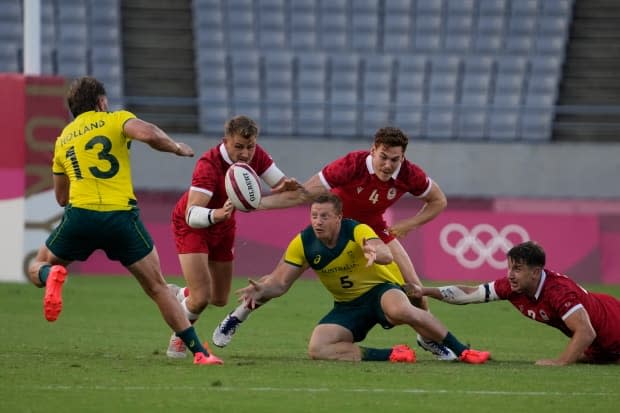Blood flow restriction training finds fans at the Olympics, but it comes with risks

A newly popular and physically uncomfortable training technique being used by some competitors at the Olympics has experts torn on its benefits and risks.
Athletes at Tokyo 2020 — like Americans Kayla Miracle, a wrestler, and Michael Andrew, a swimmer — have been seen on social media and in the practice pool restricting blood flow to certain limbs with tourniquets.
Blood flow restriction (BFR) training started out in Japan and flew under the radar for decades before gaining popularity in recent years, according to researcher Jamie Burr, an associate professor of human health and nutritional sciences at the University of Guelph. He's been studying BFR for more than a decade in his lab.
BFR lets athletes do lighter workouts while tricking their body into responding as if they were training harder, he said in an interview with CBC News. But it comes with risks.
"It actually feels like you're lifting much heavier weights," said Burr, who's tried it himself.
The effect is small, he said, but worthwhile for elite athletes.
"The changes we're talking about are typically in the range of, let's call it one to three per cent. At the Olympic Games, that's the margin within being on the podium or being off the podium or maybe not even making the finals."
But BFR carries risks, including neurological damage and blood clots, if done incorrectly, he said.
Studies of BFR have seen mixed results. Two small studies, of 17 powerlifters and 31 rowers, found that BFR increased muscle gains and maximum oxygen uptake, respectively.
But other meta-analyses have found that lifting lighter weights with BFR is either equally effective or less effective than just lifting heavier weights.
'Horrible experience'
Some players on Canada's Olympic rugby team use BFR, but only for rehab training after an injury, according to Danielle Mah, a physiotherapist who worked with some of the players until they left for Tokyo.
"It's, like, a horrible experience, but they undertake it, for sure," she said.

"It's an uncomfortable process, but the fact that they can retain muscle mass after surgeries, situations where they aren't able to train, it's a fantastic tool."
She said the rugby team doesn't use it for general training because the benefits are minimal compared to traditional weight training.

Dr. Christopher Raynor, an orthopedic sports medicine physician in Cornwall, Ont., says rehab training is the right time to use BFR. He says it works for patients who are physically limited, like people who have just been injured or had surgery, but he wants to see more evidence that it works for more general training.
"Maybe this works, but I can't really hang my hat on it," Raynor said in an interview.
The studies that have been done used small sample sizes, he noted, and the ideal amount of compression is not yet known.

He says Olympic athletes can try BFR because they're in a unique position.
"They're willing to take the risk because, if you can finish one hundredth of a second before your opponent, that makes you the gold medallist and them the silver medallist. So they're willing to do that," he said.
"But we have to also keep in mind that when they travel, they have a complete medical team that is with them."
Timothy Caulfield, the Canada Research Chair in health, law and policy at the University of Alberta, says BFR is different than other fitness trends that pop up at every Olympic Games.
It has "biological plausibility," he said, whereas trends like cupping — which Michael Phelps and Prime Minister Justin Trudeau both tried — did not. Cupping is a technique that uses heated cups to create suction on the skin to relieve pain.
"I think we always need to be careful about how science is translated, especially in the exercise space where there's so many variables involved," Caulfield said.
"Often these things that are presented as if they're going to have this huge, huge benefit. But often for the recreational athlete, the benefit might be much, much smaller, if it exists at all."

